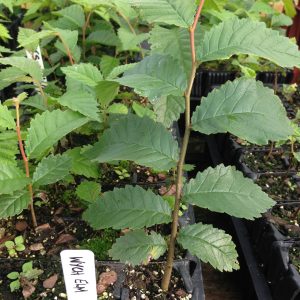Description
Hazel – Corylus avellana is the only hazel native to Scotland, and there are no sub species. The name Corylus is akin to ancient Gaelic coll and modern Gaelic caltuinn. This gift tree is grown from seed collected locally, nurtured to a young sapling in the isle of Eigg Tree Nursery. These trees are cell-grown saplings, ranging from approximately 20-60cm in height. Presented in a hessian bag protecting the roots in transit along with an information sheet with planting guidance, all enclosed and delivered in a postal tube.
Cell-grown trees can be planted all year round. Please be aware that if purchased in autumn/winter trees will be dormant and in spring/summer they will be actively growing.
If you would like to add a message to go along with your gift, you can do so on the checkout page.
To continue protecting bio-security, trees will only be sold within the UK, no international postage available.
Of all the trees that have a significant place in Celtic lore (and pre-Celtic, pan-Celtic and sub-Celtic) some six to nine species stand out, and hazel is certainly one of these. Its early presence, its wide geographical spread and density, and the abundance of its values to the environment and to people all contribute to its high ranking in the hierarchy of sacred plants. Bounteous and hardy, it has been used and venerated by peasants, priests and heroes for thousands of years, exploited and celebrated without taboo but with layers of ritual and symbolism. Pliable straight hazel shoots called ‘withies’ grow up from the base. The straighter stems and coppice growth have a wide variety of applications. Thin stems are used for basketry, including fishing creels, and for pea and bean poles; traditionally they were used as switches for driving cattle, to protect them against sickness. Thicker stems are used for thatch supports, for walking sticks and shepherds crooks, and for hurdles – the woven fence sections once so widely used. Leaves have been used in dying and a foodstuff for cows to increase their milk-yield. The nuts can be eaten as they are, or dried and ground and mixed with flour. It is recorded the the garrison of Robert Bruce’s castle on Loch Fyne was detailed to gather great quantities of hazelnuts to supplement their winter diet. In the past, hazelnuts were rubbed on furniture, where their oils imparted a polish and acted as a preservative.
Hazel will grow anywhere where the soil is not too acidic. It will do particularly well if planted with oak leaf mould and where the topography and climate allow for a balance of good damp ground and good drainage. With a maximum height of 6 – 10 metres, the hazel is a small tree, and because of its natural tendency to have a crooked and leaning trunk, with vigorous roots from root and trunk, it is often termed a shrub. The fact that the majority of specimens have been coppiced in the past further increases their shrubbery appearance: when the main stem is cut it encourages a profusion of straight stems. These can be harvested in their turn, which increases the life expectancy of the tree. Hazel is very important for mosses, lichen, liverworts and fungi, particularly in the mild, wet climate of the west coast where the air is relatively clean.








Reviews
There are no reviews yet.